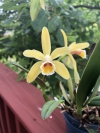|
|
|
|
|
| |
Flasks of
Cattleya luteola 'MC8376' × self |
|
| |
|
|
| |
| Number: |
TN9444 |
| Name: |
Cattleya luteola 'MC8376' × self
|
| Type: |
self (What's that?) |
|
Click to Enlarge

Pod Parent Blooming Plant |
|
|
|
| |
Culture Notes from Donor: Parent plant: Temperature range Warm-Intermediate 87-64°F, cooler season Intermediate 83-60°F. This plant is grown indoors under full-spectrum LED lights, but also receives filtered light through a west window. Humidity is generally over 50 percent, but sometimes drops below 40 percent during Winter. I water the plant with reverse osmosis water supplemented with K-Lite fertilizer a few times per week. Potted in Cattleya Imperial Potting Mix from rePotme.com.
Comments: Parent plant: Plant is an offspring of Cattleya luteola 'GC' (4n) × 'H&R' (4n). It blooms reliably on multiple leads in the Summer each year.
For additional origin/habitat information supplied courtesy of
Charles and Margaret Baker, see further below, near the bottom of this page.
|
Temperatures we attempt to use in the lab & greenhouse:
| For Species: |
|
Spring, Summer, Autumn, Winter: days average 85°F, nights 66°F; best fit is Warm-Intermediate 87-64°F
(Source:
Baker's Web OSC) |
| For Genus: |
|
Spring, Summer, Autumn, Winter: days average 83°F, nights 60°F; best fit is Intermediate 83-60°F
(
) |
|
About the name...
| Etymology of |
Cattleya |
|
Named in honor of William Cattley, English horticulturist in the 19th century.
(Source:
Pridgeon 1992) |
| Etymology of |
luteola |
|
From Latin "luteolus", yellowish.
(Source:
Hawkes 1978) |
| Pronunciation of |
Cattleya |
|
KAT-lee-ya
(Sources:
Pridgeon 1992, Hawkes 1978) |
| Pronunciation of |
luteola |
|
loo-tee-OH-la
(Source:
Hawkes 1978) |
|
If you would like to direct someone to this web page, please copy and paste this URL into your email:
http://troymeyers.com/d?019444
| Flask Information |
| Availability: |
Capsules have been harvested, and we are waiting for germination. |
| You should: |
Make a notification request now.
When this germinates, we'll let you know, and you can reserve a flask at that time if you like. Your notification request serves as a place-holder in line for flasks later, so it's best if you place the notification request as early as possible. If you wait, you'll be further down in line for flasks. |
| Expected Flask Price: |
$40.00 per flask of 25 (min.) plants
|
|
You might also want to:
|
View the seed assay for this item.
View items of the same species.
View items of the same genus.
|
| Ordering Information |
| You are not currently logged in. |
|
You must be a registered user and be logged in to reserve a flask or place a notification request. Please log in:
|
|
|
|
|
|
| |
The origin/habitat information below is supplied courtesy of Charles and Margaret Baker
The following information is based on the name of the plant provided by the donor, and assumes that the name is correct. If the plant has been misidentified, then the following information may not be correct.
This text is copyrighted by the Bakers and may not be reproduced without permission.
ORIGIN/HABITAT: Brazil, Peru, Ecuador, and Bolivia. Plants grow in the
Amazon Basin from west of Manaus, Brazil to the lower eastern slopes of
the Andes west of Iquitos, Peru. Cattleya luteola has spread both north
and south through the eastern foothills of the Andes. Plants are found in
scattered locations in Bolivia and Ecuador. They also have spread onto the
Brazilian Plateau southwest of Manaus. Plants usually grow in relatively
shaded locations on rough-barked trees along rivers in wet, lowland,
tropical forests at 650–2300 ft. (200–700 m).
More about this information and the Bakers...
|
|
|
| |
|
|
|